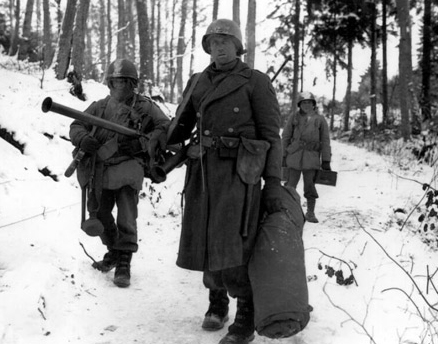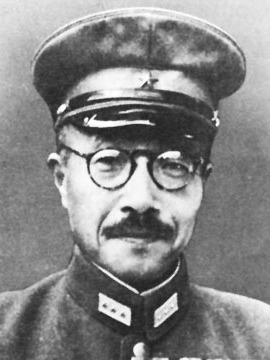On 2 February 1943, in what is considered the turning point of the Second World War in Europe, the final remnants of the German Sixth Army surrendered at the Battle of Stalingrad.
Stalin’s City
The city, originally called Tsaritsyn, was renamed Stalingrad, Stalin’s city, in April 1925, in recognition of Joseph Stalin’s leading role in saving the city from the counterrevolutionary ‘Whites’ during the Russian Civil War. (The fact that Leon Trotsky was more instrumental in saving Tsaritsyn was quietly forgotten). Considered important because of its supply of oil, the symbolic significance of Stalingrad, bearing the name of the Soviet leader, soon outweighed its strategic importance.
‘Not One Step Back’
 The Germans started their attack on Stalingrad, Operation Blue, on 28 June 1942. Led by the Sixth Army, Germany’s largest wartime army commanded by General Friedrich Paulus (pictured), the Germans were fully expecting a total victory as they pushed the Soviet forces back.
The Germans started their attack on Stalingrad, Operation Blue, on 28 June 1942. Led by the Sixth Army, Germany’s largest wartime army commanded by General Friedrich Paulus (pictured), the Germans were fully expecting a total victory as they pushed the Soviet forces back.
The swift German advance alarmed Stalin so much, he issued his infamous ‘Not One Step Back’ directive of 28 July, ordering execution for the slightest sign of defeatism. Behind the Soviet frontlines roamed a second Soviet line ready to shoot any retreating ‘cowards’ or ‘traitors of the Motherland’. As Georgy Zhukov, one of Stalin’s top generals, said, ‘In the Red Army it takes a very brave man to be a coward’.
By 23 August, the German advance had reached the outskirts of Stalingrad and, with 600 planes, unleashed a devastating aerial bombardment. Entering the city, the Germans, along with their Axis comrades, comprising of Italians, Romanians and Hungarians, fought the Soviets street for street, house for house, sometimes room for room. This, as the Germans called it, was rat warfare, where a strategic stronghold changed sides so many times people lost count, where the front lines were so close one could throw back a grenade before it exploded, where snipers took their toll on the enemy, and where a soldier’s life expectancy was three days – if lucky.
 A small fleet of ships and boats arrived on the scene and managed to pluck a few survivors from the icy waters and rescued many of those on the lifeboats. Over a thousand were
A small fleet of ships and boats arrived on the scene and managed to pluck a few survivors from the icy waters and rescued many of those on the lifeboats. Over a thousand were  The ship was named after the assassinated leader of the Swiss Nazi Party (yes, Switzerland in the 1930s had its own Nazi Party), murdered in his own home in February 1936 (Wilhelm Gustloff, pictured).
The ship was named after the assassinated leader of the Swiss Nazi Party (yes, Switzerland in the 1930s had its own Nazi Party), murdered in his own home in February 1936 (Wilhelm Gustloff, pictured). But whereas Anne’s diary is a carefully kept journal over a period of two years, Tanya’s was little more than a few scribbled lines over six sheets of notepaper.
But whereas Anne’s diary is a carefully kept journal over a period of two years, Tanya’s was little more than a few scribbled lines over six sheets of notepaper. Reinhard Heydrich
Reinhard Heydrich Galeazzo Ciano’s father had made a name for himself as an admiral during the First World War. An early supporter of Benito Mussolini’s, he built his fortune through some unethical business deals. Thus, Galeazzo, born 18 March 1903, was brought up in an environment of wealth and luxury, and inherited his father’s love for fascism. Father and son both took part in Mussolini’s 1922 ‘March on Rome’.
Galeazzo Ciano’s father had made a name for himself as an admiral during the First World War. An early supporter of Benito Mussolini’s, he built his fortune through some unethical business deals. Thus, Galeazzo, born 18 March 1903, was brought up in an environment of wealth and luxury, and inherited his father’s love for fascism. Father and son both took part in Mussolini’s 1922 ‘March on Rome’. Born in Tokyo on 30 December 1884, Hideki Tojo, the son of a general, was brought up in a military environment that held little regard for politicians or civilians. An admirer of Adolf Hitler, Tojo advocated closer ties between Japan and Germany and Italy, and in September 1940, the three Axis powers signed the Tripartite Pact.
Born in Tokyo on 30 December 1884, Hideki Tojo, the son of a general, was brought up in a military environment that held little regard for politicians or civilians. An admirer of Adolf Hitler, Tojo advocated closer ties between Japan and Germany and Italy, and in September 1940, the three Axis powers signed the Tripartite Pact. The Allies knew there was a build-up of German troops and equipment around the Ardennes but never believed Hitler was capable of such a bold initiative. Only the day before the attack, the British commander,
The Allies knew there was a build-up of German troops and equipment around the Ardennes but never believed Hitler was capable of such a bold initiative. Only the day before the attack, the British commander,  In Britain or the US, we may consider the war to have started in 1939 or 1941, but many modern historians consider this to be too Eurocentric and that the war had really started in 1937 with the outbreak of hostilities between China and Japan. (Pictured is the Eternal flame at the Nanjing massacre memorial).
In Britain or the US, we may consider the war to have started in 1939 or 1941, but many modern historians consider this to be too Eurocentric and that the war had really started in 1937 with the outbreak of hostilities between China and Japan. (Pictured is the Eternal flame at the Nanjing massacre memorial). The US may have been expecting
The US may have been expecting  On 17 October 1941, the prospect of war became more real – Japan’s prime minister, Fumimaro Konoye, known for his restraint and sense of compromise,
On 17 October 1941, the prospect of war became more real – Japan’s prime minister, Fumimaro Konoye, known for his restraint and sense of compromise,  During the Second World War, the city of Leningrad (modern-day St Petersburg) was in the midst of a devastating 900-day blockade that lasted from September 1941 until January 1944. The German army had laid siege to the city, bombarded it and cut off all supplies in its attempt to ‘wipe it off the map’, as Hitler had ordered.
During the Second World War, the city of Leningrad (modern-day St Petersburg) was in the midst of a devastating 900-day blockade that lasted from September 1941 until January 1944. The German army had laid siege to the city, bombarded it and cut off all supplies in its attempt to ‘wipe it off the map’, as Hitler had ordered.